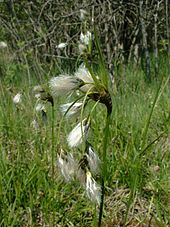- Cyperaceae
-
This article is about plants in the family Cyperaceae. For other uses of "sedge", see Sedge (disambiguation).
Cyperaceae 
Cyperus polystachyos flower head Scientific classification 
Kingdom: Plantae clade: Angiosperms clade: Monocots clade: Commelinids Order: Poales Family: Cyperaceae
Juss.Genera About 109 (not all listed here)
Cyperaceae are a family of monocotyledonous graminoid flowering plants known as sedges, which superficially resemble grasses or rushes. The family is large, with some 5,500 species described in about 109 genera.[1] These species are widely distributed, with the centers of diversity for the group occurring in tropical Asia and tropical South America. While sedges may be found growing in all kinds of situations, many are associated with wetlands, or with poor soils. Ecological communities dominated by sedges are known as sedgelands.
Features distinguishing members of the sedge family from grasses or rushes are that members of the sedge family have stems with triangular cross-sections (with occasional exceptions), and their leaves are spirally arranged in three ranks (grasses have alternate leaves forming two ranks).[2][3][4]
Some well-known sedges include the water chestnut (Eleocharis dulcis) and the papyrus sedge (Cyperus papyrus), from which the Ancient Egyptian writing material was made. This family also includes cotton-grass (Eriophorum), spike-rush (Eleocharis), sawgrass (Cladium), nutsedge or nutgrass (Cyperus rotundus, a common lawn weed), the large genus of Carex, and white star sedge (Rhynchospora colorata).
Selected genera
- Abildgaardia
- Actinoscirpus
- Actinoschoenus
- Afrotrilepis
- Alinula
- Amphiscirpus
- Androtrichum
- Arthrostylis
- Ascolepis
- Becquerelia
- Baumea
- Blysmus
- Bolboschoenus
- Bulbostylis
- Carex
- Cladium
- Cymophyllus
- Cyperus
- Desmoschoenus
- Dulichium
- Eleocharis
- Eleogiton
- Elyna
- Eriophorum
- Ficinia
- Fimbristylis
- Fuirena
- Gahnia
- Hypolytrum
- Isolepis
- Kobresia
- Kyllinga
- Lagenocarpus
- Lepidosperma
- Lepironia
- Lipocarpha
- Machaerina
- Mapania
- Mariscus
- Mesomelaena
- Morelotia
- Oreobolus
- Oxycaryum
- Pycreus
- Remirea
- Rhynchospora
- Schoenoplectus
- Schoenus
- Scirpodendron
- Scirpoides
- Scirpus
- Scleria
- Trichophorum
- Uncinia
- Websteria
References
- ^ R. Govaerts & D. A. Simpson, with J. Bruhl, T. Egorova, P. Goetghebeur & K. Wilson (2007). Word Checklist of Cyperaceae: Sedges. Royal Botanic Gardens, Kew. ISBN 9781842461990.
- ^ "Grasslike non-grasses". http://www.backyardnature.net/fl_caryx.htm.
- ^ Peter W. Ball, A. A. Reznicek & David F. Murray. "210. Cyperaceae Jussieu". In Flora of North America Editorial Committee. Magnoliophyta: Commelinidae (in part): Cyperaceae. Flora of North America. 23. Oxford University Press. ISBN 9780195152074. http://www.efloras.org/florataxon.aspx?flora_id=1&taxon_id=10246.
- ^ Brian R. Speer (September 29, 1995). "Glumiflorae: More on Morphology". University of California, Berkeley. http://www.ucmp.berkeley.edu/monocots/glumiflorae/glummm.html. Retrieved March 23, 2007.
External links
- Cyperaceae in L. Watson and M.J. Dallwitz (1992 onwards). The families of flowering plants: descriptions, illustrations, identification, information retrieval. Version: 27 April 2006. http://delta-intkey.com.
- Visual and matrix-based keys to Carex, Cyperus, Eleocharis, Fuirena, Rhynchospora, and Scleria of North America @ Louisiana State University Herbarium Jones, T. M., Ferguson, D. M., and Reed, C. S. (2011)
- Family Cyperaceae Flowers in Israel
 Chisholm, Hugh, ed (1911). "Cyperaceae". Encyclopædia Britannica (11th ed.). Cambridge University Press.
Chisholm, Hugh, ed (1911). "Cyperaceae". Encyclopædia Britannica (11th ed.). Cambridge University Press.
Categories:- Cyperaceae
- Poales families
Wikimedia Foundation. 2010.

